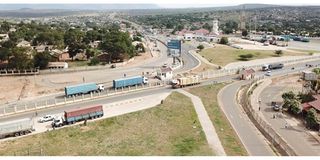Prime
EAC tariff inconsistencies threaten regional trade growth, experts say

What you need to know:
- Analysts said that resolving CET-related issues and eliminating non-tariff barriers (NTBs) could unlock up to $63.4 billion in regional trade, boosting intra-EAC trade by 54 percent
Arusha. National interests are increasingly trumping regional commitments, creating major hurdles for the effective implementation of the East African Community’s (EAC) Common External Tariff (CET), experts have warned.
This concern was raised during a Post-Budget Webinar on the implications of the EAC’s 2025/26 tax measures on regional trade and investment, organised by the East African Business Council (EABC).
Analysts said that resolving CET-related issues and eliminating non-tariff barriers (NTBs) could unlock up to $63.4 billion in regional trade, boosting intra-EAC trade by 54 percent.
However, inconsistent implementation of the CET, manifested through widespread use of Stays of Application (SoAs) and Country-Specific Duty Remissions (SDRs), continues to hinder progress.
Acting executive director of the EABC, Adrian Njau, said that these measures distort the region’s customs union by undermining uniform duty application.
He said the resulting uneven playing field encourages imports from outside the region, discourages local investment, and weakens regional value chains, particularly in manufacturing and agro-processing.
Recent data show that in the 2023/24 and 2024/25 financial years, SoAs affected over 30 percent of EAC tariff lines, while SDRs impacted more than 10 percent.
The majority of these relate to products in the 25 percent and 35 percent CET bands, including textiles, steel, plastics, paper and leather goods, key sectors for regional industrialisation.
EAC Legal Notice No EAC/171/2025, dated June 30, 2025, reveals that over 2,464 tariff lines, about 41.3 percent, have been adjusted through stays or remissions.
Experts say this trend casts doubt on the bloc’s ability to meet its target of increasing intra-EAC trade to 40 percent by 2030. Despite a 14.17 percent rise in total EAC trade in 2024, reaching $124.9 billion, intra-EAC trade only grew by 9.35 percent to $15.2 billion.
This accounts for just 12.17 percent of the bloc’s total trade, with the remaining 87.83 percent conducted with external markets.
Participants in the webinar highlighted that final products enjoying duty remission in one country, yet lacking EAC origin status, are subjected to full CET rates when traded within the bloc.
This undermines competitiveness and stifles cross-border trade. The EABC has urged Partner States to uniformly apply the CET, eliminate equivalent charges on EAC-originating goods, and introduce structured consultations ahead of pre-budget cycles to avoid derailing regional integration efforts.
It also proposes regional guidelines limiting SoAs to a maximum of three years, with a gradual phase-out to maintain CET predictability.
Currently, only Kenya, Rwanda, Tanzania, and Uganda have read their 2025/26 budgets. The remaining EAC members, Burundi, DR Congo, Somalia, and South Sudan, are yet to present their fiscal bills.
Each year, pre-budget consultations are held to propose CET adjustments, which are then approved by the Council of Ministers through legal notices.
The EABC also recommends annual reviews of SoAs to prevent trade distortions and calls for an EAC-wide duty remission scheme for industrial inputs to create a level playing field.
Greater private sector involvement in national budget consultations was also suggested to ensure tax measures align with EAC objectives.
Inconsistent domestic tax regimes are another challenge. Corporate income tax stands at 28 percent in Rwanda, and 30 percent in Tanzania, Kenya, and Uganda.
Employer-side levies, including social security and workers’ compensation, are highest in Tanzania at 14 percent and lowest in Rwanda at 8.3 percent.
Employee-side taxes reach 45 percent in Uganda and 40 percent in Tanzania.
Withholding tax on dividends and services ranges between 5 and 15 percent across the region, disadvantaging EAC suppliers and harming competitiveness.
VAT also varies, 18 percent in Tanzania, Uganda, and Rwanda, and 16 percent in Kenya. Excise duties on services differ further, undermining the goal of harmonised regional tax policy.
Experts stressed that harmonising these tax measures is critical to boost intra-EAC trade and investment, enhance service mobility, and create a predictable business environment across the region.




